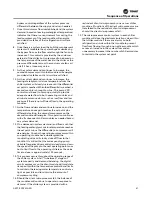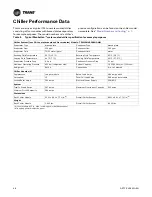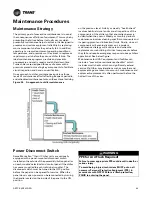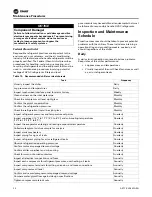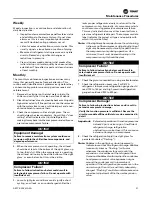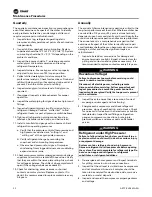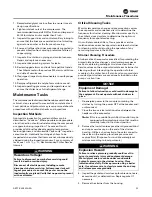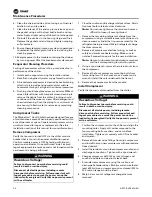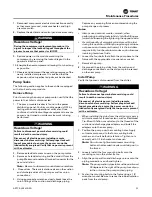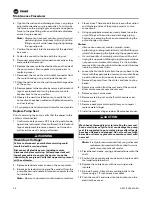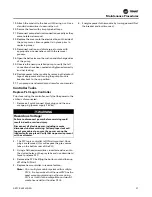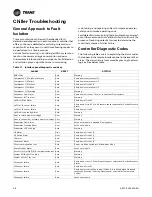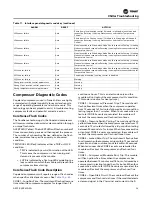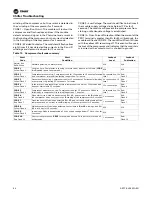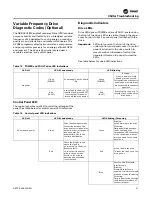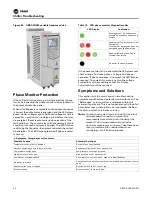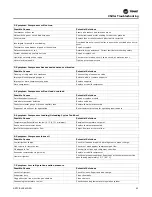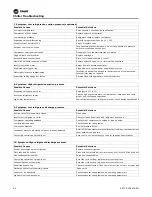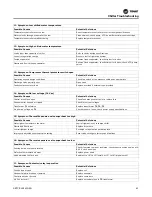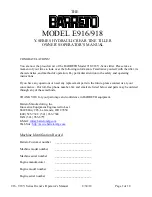
Maintenance Procedures
50
ARTC-SVX002A-EN
Federal Clean Air Act
Responsible refrigerant practices are important to the
environment, our customers, and the air conditioning
industry. All technicians who handle refrigerants must be
properly certified. The Federal Clean Air Act prescribes
procedures for handling, reclaiming, recovering, and
recycling of refrigerants and the equipment that must be
used in maintenance procedures involving potential
leakage of HVAC refrigerants. State and local
governments may have additional requirements that must
be followed to responsibly handle HVAC refrigerants.
Inspection and Maintenance
Schedule
Proactive measures should be taken to prevent potential
problems with the chillers. These include maintaining a
operational log and conducting weekly, quarterly, and
annual inspections of the chiller.
Daily
A daily visual inspection can reveal obvious problems.
Keep notes of the chiller performance:
•
Log pressures and temperatures.
•
Visually inspect of the unit. Check for noises, as well
as, oil or refrigerant leaks.
NOTICE
Component Damage!
Failure to follow instructions could damage sensitive
electronic components beyond repair. To prevent arcing
or surges of electrical current, do not use wires or
cables to jump components or bypass the
manufacturer's safety systems.
Table 10. Recommended chiller service intervals
Task
Frequency
Visually inspect the chiller
Daily
Log pressure and temperatures
Daily
Inspect touchscreen interface panel for alarm history
Weekly
Clean strainers on the inlet water pipe
Monthly
Check the compressor oil level sight glass
Monthly
Confirm the glycol concentration
Monthly
Confirm the refrigeration pressures
Monthly
Check the refrigeration liquid line sight glass
Monthly
Inspect refrigerant pressures and temperature set points
Quarterly
Inspect superheat (10 °F to 12 °F [5°C to 6°C]) and sub-cooling temperatures
(10°F to 15°F [5°C to 8°C])
Quarterly
Inspect the evaporator entering and leaving evaporator temperature
Quarterly
Collect water/glycol mixture sample for analysis
Quarterly
Inspect crankcase heaters
Quarterly
Inspect piping for signs of leaks
Quarterly
Inspect refrigerant piping for oil or refrigerant leaks
Quarterly
Observe refrigeration operating pressures
Quarterly
Confirm motor amperage draw and voltage
Quarterly
Confirm chiller superheat and sub-cooling
Quarterly
Check for worn or burned contactors
Quarterly
Inspect all electrical connections and fuses
Annually
Inspect each compressor for refrigerant pressures, overheating, oil leaks
Annually
Inspect compressor terminals for pitting, corrosion, and loose connections
Annually
Inspect compressor oil level
Annually
Confirm and record compressor amperage draw and voltage
Annually
Compare water/glycol flow against design specifications
Annually
Tighten compressor rotalock nuts
Annually












